- VLSFO switch with respect to IMO 2020 has gone smoother to an extent in spite of price spikes for compliant fuels.
- Suphur content of compliant fuels is one of the most important deciders in the IMO 2020 fuel switch.
- Residual fuel in barges and pipes pose a serious threat in making the fuels dirtier as they reach the engine.
- With the Shipping industry’s biggest problem so far, the maritime sector has managed to sail through the scenario smoother.
The IMO 2020 global switch to low sulphur bunkers has, so far, failed to materialize, reports the Ship & Bunker News Team.
IMO 2020: Global sulphur cap
Theodore Veniamis, Union of Greek Shipowners’ president, commented that thousands of ships could suffer engine blackouts as a result of switching to the new fuels, resulting in disorderliness in the oceans.
But with respect to the indicators so far, the new VLSFO fuels developed to meet the global 0.50% sulfur cap are presenting fewer issues than the HSFO they replaced.
Buyers and suppliers all over the globe feel that the transition to VLSFO has been smooth so far. One major buyer even told Ship & Bunker they were experiencing fewer instances of off-spec fuel with VLSFO than they have been with HSFO.
Sulphur compliant fuels
Predictably enough, the main problem being experienced so far is with the sulfur content of the new fuels. “Unfortunately there’s been a lot of off-spec products received with sulphur above 0.5%,” a large buyer in Northwest Europe and the Mediterranean said.
“The suppliers’ samples are always ok, which means we are worried in case of controls, because the responsibility will fall on owners alone.” “Needless to say, the prices are sky-high.”
Traditional commercial terms would allow for VLSFO with sulfur content up to 0.53% being considered acceptable and any subsequent claims likely to be rejected, but the IMO’s own terms leave anything with more than 0.50% sulfur potentially being found non-compliant.
Tanks and pipes have residual VLSFO
Complicating matters further is that barges, fuel tanks and pipes that have not been thoroughly cleaned since handling high sulfur fuel oil could leave VLSFO that was earlier tested below 0.50% considerably dirtier by the time it passes through them to the engine.
Danish container giant Maersk also appears to be surviving the transition unscathed. “The switch went well and we haven’t experienced issues with performance or fuel availability,” said Ole Graa Jakobsen, head of fleet technology at Maersk.
“The switch went well and we haven’t experienced issues with performance or fuel availability,” the company’s head of fleet technology, Ole Graa Jakobsen, told the Wall Street Journal this week.
VLSFO: Not for all
In spite of all these factors, still a sector is not all up for VLSFO.
In an interview with Value Investor’s Edge, Ardmore Shipping CEO Anthony Gurnee said there have been “substantial problems” with the new fuels in some cases. “We’ve rejected a lot of VLSFO stems,” Gurnee said.
“We don’t have any operational problems resulting at the moment, but we’ve heard of some ships that have had extensive damage to their main engines as a consequence of bad fuel,” he added.
He further said, “Overall we get the sense that the lead time for arranging bunker supply and the quality issues that are arising are turning out to be extremely disruptive.”
Gurnee suggested some owners are buying additional marine gasoil as well as VLSFO to use in case they have problems with the VLSFO. Keeping in mind the VLSFO quality last year, the shipping industry can feel relieved with the arrival of the new fuels.
Debate over sulphur content
Disputes over sulfur content remain a major irritant, and it could gain momentum later this year if port states start aggressively pursuing cases of non-compliance for fuels only just over the 0.50% limit.
Large amounts of the sulfur disputes currently arising will result from HSFO residue left on bunkering infrastructure.
As this residue is gradually washed away, buyers’ and sellers’ impressions of the sulfur content of the fuels they handle should start to converge and fewer disputes will arise.
The shipping industry is currently baffled with one of the biggest operational challenges any industry has faced in recent years. The shift is overwhelming and the maritime industry is handling this shift in a progressive manner.
Did you subscribe to our daily newsletter?
It’s Free! Click here to Subscribe!
Source: Ship & Bunker






















